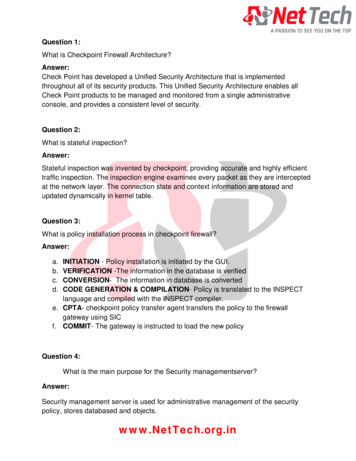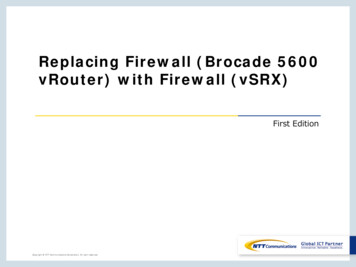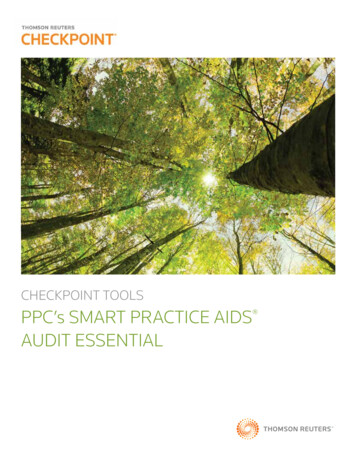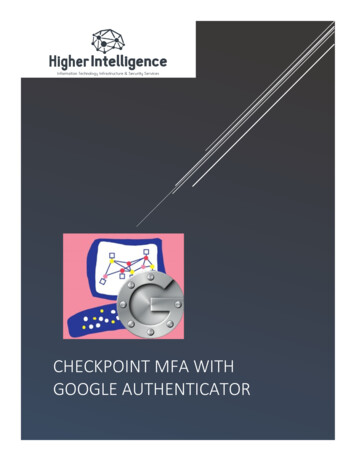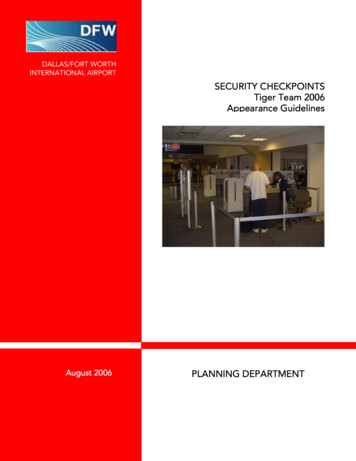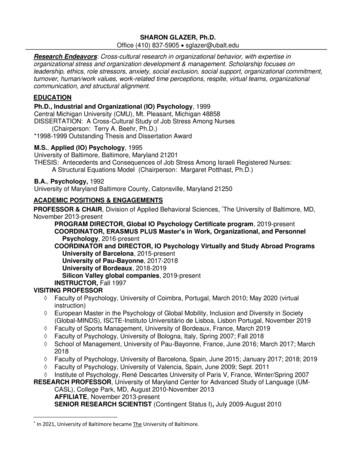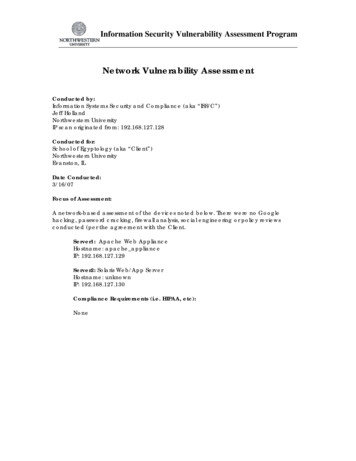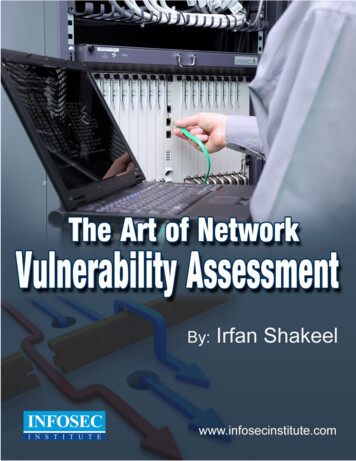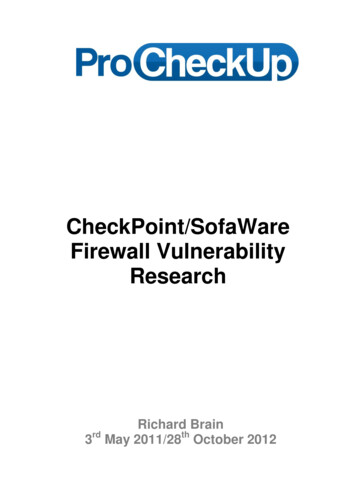
Transcription
CheckPoint/SofaWareFirewall VulnerabilityResearchRichard Brain3rd May 2011/28th October 2012
CheckPoint/SofaWare Firewall Vulnerability ResearchTable of Contents1Introduction . 41.2Photographs of the hardware variations over time. 52Hardware overview. 6Increasing memory capacity . 63Diagnostics connector and Linux shell . 113.2 . 114Filing system layout . 144.2Software functionality . 15NGX Command line interpreter and serial console. 164.3Port Scan Findings . 165 Changes in the screen appearance, and OS image size over the differentversions of NGX OS . 176Notes . 196.27Default user account . 19New vulnerabilities . 207.2Local access to privileged information . 207.3Unauthenticated information disclosure . 217.4Cross Site Scripting (XSS) . 227.5Unauthenticated persistent XSS. 227.6Reflective XSS . 257.7Offsite redirection . 268Historic vulnerabilities previously published. 278.2Unauthenticated XSS on login CVE-2007-3462 . 278.3CSRF on the password change form CVE-2007- 3464 . 278.4Default user account CVE-2007-3465 . 289Credits. 2810Legal . 2811Appendix – proof of concept . 29(c) 2012 www.procheckup.com
CheckPoint/SofaWare Firewall Vulnerability ResearchPrefaceThis is one of a series of papers investigating selected security related hardware,particularly hardware which is commonly found within DMZ’s (DeMilitarised Zones) orprotecting the periphery of the DMZ such as firewalls.The intent of these papers is to assist security professionals in coming to a betterunderstanding of security related hardware, how it functions, the operating systemused and if any of the type of vulnerabilities that were found to exist.(c) 2012 www.procheckup.com
CheckPoint/SofaWare Firewall Vulnerability Research1IntroductionThis paper is the result of various security assessments performed on severalCheckPoint/SofaWare firewalls in both a controlled (computer lab) and s.SeveraldifferentCheckPoint/SofaWare firewall models were purchased for testing in our computerlab. By having full access to the target devices, it becomes possible to discover newvulnerabilities that could be missed during a standard unauthenticated penetrationtest.CheckPoint/SofaWare firewalls were chosen as they are popular compact UTM(Unified Threat Management) devices, commonly found deployed in corporatesatellite offices sometimes even within private households.SofaWare based firewalls have also been resold as SofaWare S-Box firewalls, NokiaIP30 or NEC SecureBlade 100. The @Office firewalls are sold as entry level devices,with the VPN-1 Edge X and UTM-1 EDGE sold as corporate solutions.The CheckPoint/SofWare firewalls are designed as an all in one security andconnectivity solution, for small office environments as UTM’s they provided thefollowing:Gateway antivirus: stopping virus and worms from reaching the network.Firewall and IPS: providing a stateful inspection firewall and intrusion preventionsystem.Connectivity: initially only VPN access was provided, though in later modelsconnectivity expanded to include Wi-Fi and ASDL connectivity options. The latermodels even have USB ports so that they can act as print servers, or connectthrough external modems.This paper describes the hardware and some technical details, along with thesecurity vulnerabilities found to be present within the devices. The intent is to assistcorporate security officers to understanding the risks when addingCheckPoint/SofaWare devices to their networks.We found Embedded NGX OS which is the operating system that runs on theCheckPoint/SofaWare firewalls to be vulnerable to the following classes ofvulnerabilities totalling nine new flaws in all:Local privileged access to admin credentials without authentication needed.Unauthenticated information disclosureUnauthenticated persistent Cross Site Scripting (XSS)Unauthenticated reflective Cross Site Scripting (XSS)Authenticated Cross Site Scripting and offsite redirection.The persistent Cross Site Scripting flaws are particularly dangerous as the protectivenature of the firewall can be subverted, placing at risk any internal network orwireless users who might be presented with malware laden pages hosted by thefirewall a proof of concept is demonstrated later.NGX OS software versions from 5.094 to 8.2.26 were tested, users of SofaWarefirewalls are strongly recommended to upgrade past version 8.2.44 (releasedOct/Dec 2011) which fixes these newly discovered issues.(c) 2012 www.procheckup.com
CheckPoint/SofaWare Firewall Vulnerability Research1.2Photographs of the hardware variations over 4SBX166LHGE-5SBX166LHGE-6(c) 2012 www.procheckup.com
CheckPoint/SofaWare Firewall Vulnerability Research2Hardware overviewThe CheckPoint/SofaWare firewall family uses embedded CPU’s based on the MIPsarchitecture, with the early models being based on a 133MHZ processor and the laterones up to a 200MHz processor.The hardware comprises of a central processor, supported by typically 64MB ofdynamic RAM and two flash RAM chips which are used to store the firmware.Supporting the CPU is an Ethernet switch controller chip which manages the fourEthernet ports fitted, in later models a USB controller chip was added to whichallowed USB printers and modems to be connected.Increasing memory capacityOf interest is the increasing amount of flash RAM fitted to store the operating system,with the earliest models unable to run the current firmware. The two flash RAM chipswere found to be fitted of varying sizes depending on hardware revision (see below).Revision (date)SBX-133LHE-1 (2002)SBX-166LHGE-2 (2004)SBX-166LHGE-3 (2006)SBX-166L HGE-4 (2005)SBXW-166LHGE-5 (2006)SBXW-166LHGE-6 (2007)Flash RAM 1 size256 Kbyte512 Kbyte512 Kbyte8 Mbyte512 Kbyte8 Mbyte(c) 2012 www.procheckup.comFlash RAM 2 size8 Mbyte16 Mbyte32 Mbyte8 Mbyte32 Mbyte16 Mbyte
CheckPoint/SofaWare Firewall Vulnerability ResearchHardware SpecificationsRevisionSpecificationSBXToshiba TMPR3927AF133LHE-1 133MHZMIPSprocessorSafe@Office 100Memory chips:32 Mbyte dynamic RAM2x M2V28S40ATP Ram(8M x 16)8 Mbyte flash RAMK9F6408U0C (8Mx8)256 Kbyte flash RAM39VF200A (128K x 16)Support chips:KS8995 Ethernet lerNo serial or DMZ, justWANManufacture date: Oct2002SBX166LHGE2Safe@Office 100BVPN-1Edge XPower: 9V AC @ 1.5ABrecisMSP2100170MHZMIPSprocessorMemory chips:64 Mbyte dynamic RAM2xHY57V561620CTRam (16M x 16)16 Mbyte flash RAMK9F2808U0C/SDTNGAHE0-128 (16Mx8)512 Kbyte flash RAM29LV400BC (256K x16)Support iverManufacturedate:approximately Jan 2004(c) 2012 www.procheckup.com
CheckPoint/SofaWare Firewall Vulnerability Research(edge) and May 2005(office)Power : 9V AC @ ory chips:64 Mbyte dynamic RAM2xHY57V561620CTRam (16M x 16)32 Mbyte flash RAMK9F5608U0D (32Mx8)512 Kbyte flash RAM29LV400BC (256K x16)Support chips:KS8995XEthernetswitch pproximately2006SBX-166LHGE-4Safe@Office 200date:AprilPower: 9V AC @ 1.5ABrecisMSP2100170MHZMIPSprocessorMemory chips:64 Mbyte dynamic RAM2x W982516CH Ram(16M x 16)8 Mbyte flash RAMS29JL064H70T (4M x16)8 Mbyte flash RAMS29JL064H70T (4M x16)(c) 2012 www.procheckup.com
CheckPoint/SofaWare Firewall Vulnerability ResearchSupport chips:IP175C Ethernet switchcontroller.2xIP102EthernettransceiverSpace for a USBcontroller and Wifi cardand connectors.Manufacturedate:approximately July 2005SBXWD166LHGE5Safe@Office 500WVPN-1Edge XPower: 5V DC @ 0200MHZMIPSprocessorMemory chips:64 Mbyte dynamic RAM2x P2V56S40BTP Ram(16M x 16)32 Mbyte flash RAMK9F5608U0D (32Mx8)512 Kbyte flash RAMS29AL004D (256k x 16)Support chips:IP175C Ethernet switchcontroller.VT6212L USB controllerManufacturedate:approximatelyDecember 2006 (Safe@Office) June 2007(VPN Edge-X)April2009(UTM-1EDGE)Power: 12V DC 1.5A(c) 2012 www.procheckup.com
CheckPoint/SofaWare Firewall Vulnerability ResearchSBXW166LHGE6VPN-1Edge WCavium200MHZprocessorCN210-200MIPSMemory chips:64 Mbyte dynamic RAM2x W9825G6CH Ram(16M x 16)24 Mbyte flash RAM3x S29JL064H70T (4Mx 16)Support chips:IP175C Ethernet switchcontroller.VT6212L USB e:approximately Jan 2007Power: 5V DC 3A(c) 2012 www.procheckup.com
CheckPoint/SofaWare Firewall Vulnerability Research3Diagnostics connector and Linux shellAll models of the CheckPoint/SofaWare firewall were found to support a Linux shellwithin the case, which directly connected to the serial port on the CPU. This providesdirect access to the underlying Linux operating system, with SBOX-II operatingsystems (NGX versions after 5.094) running on Brecis or Cavium CPU’s the consolebeing password protected. NGX releases 5.094 and earlier had no passwordprotection with immediate access given to the Linux operating system.Diagnostics connector on hardware revisions from LHGE1 to LHGE53.2Diagnostics connector on hardware revision LHGE6The diagnostics connector has the following serial settings, which changed accordingto the hardware and or firmware used as per the following table. To enablediagnostics a jumper block needed to be shorted, for revision LHGE1 a shortingjumper was not 152005760057600576005760057600No of Paritybits8N8N8N8N8N8N(c) 2012 fXon/XoffXon/XoffXon/XoffXon/XoffXon/Xoff
CheckPoint/SofaWare Firewall Vulnerability ResearchTo connect the diagnostics connector, an easily available USB to TTL convertorbased on the CP2102 chipset was used as pictured below:-Version 5.0.94 boots into an interactive Linux shell, with later versions requiringauthentication to gain access.Version 5.0.94s interactive shell(c) 2012 www.procheckup.com
CheckPoint/SofaWare Firewall Vulnerability ResearchVersion 6.0.72x interactive SBox-II shell loadingVersion 8.2.26x interactive SBox-II shell loginBy pressing the reset button and powering on, an additional bootloader shell issometimes displayed which allows new firmware to be uploaded to the device.(c) 2012 www.procheckup.com
CheckPoint/SofaWare Firewall Vulnerability Research4Filing system layoutThis information was obtained from obtaining interactive Linux shell access.One disk drive is mapped/ df -hFilesystemSizeUsed Available Use% Mounted on/dev/ramdisk15.5M 11.1M3.6M 0% /Contents of the root file system/bin (busybox other commands)/dev (system devices)/etc (system configuration files)/flash (Used in SBox-II version to mount USB flash devices)/home/lib (Holds Linux 2.0.7 libraries and 2.4.20 libraries SBox-II)/proc (system information)/root (empty)/sbin (system management commands)/usr /usr/bin/ (binaries) /usr/sbin (system management commands)/lost found (empty)/temp (backup of configuration and system files)/var (system variables, run and log files)Contents of the /etc directory in version 5.0.94 gfstabioctl.savensswitch.conf resolv.conf sysconfiggettydefsissuepam.confrun telnetd wtmplockgroupissue.netpam.drun telnetd999hostnameld.so.cache passwdsecurettyContents of the /etc directory in version 8.2.26x softwaregigatest-apcfg hotpluginittab.int passwd rcgroupinetd.conf issuepppserviceshostsinittab.ext ospfd.conf profile zebra.conf(c) 2012 www.procheckup.com
CheckPoint/SofaWare Firewall Vulnerability Research4.2Software functionalityCheckPoint/SofaWare software runs on top of the Linux operating system, whichprovides the core file system, multitasking of programs and network support.Running on top of the core Linux OS, CheckPoint/SofaWare relies on the followingprograms:SWWatchdog: restarts the firewall on a hardware failure/glitch.Sw sh/swcmd: provides the NGX CLI, accessible by serial port or support option inthe web interface.SafeAtHome: provides the core firewall functionality.Programs running can be determined by issuing the ps command which when runreturns the following:PID Uid Stat Command10S sh /sbin/init20S [kflushd]30S [kupdate]40S [kpiod]50S [kswapd]80S sh /etc/sofaware17 0S /bin/sh31 0R /usr/sbin/SWWatchDog 180 2 30 30 (to restart machine in case ofh/w failure)32 0S SafeAtHome 31 251 0R ps(c) 2012 www.procheckup.com
CheckPoint/SofaWare Firewall Vulnerability ResearchNGX Command line interpreter and serial consoleConnecting a computer to the external serial port of the firewall obtains a simpleinteractive command line environment, which allows the firewall configuration to bemodified and saved. Please Google the “Checkpoint Embedded NGX CLI ReferenceGuide” for further information on this environment.On SofaWare SBox-II systems the /bin/sw sh binary carries out this functionality,and is simply initialised in the following manner by the /etc/inittab.ext Linux boot file :# inittab for uClinux# Format:# n/agetty 57600 ttyZttyS0:vt100:/sbin/agetty -n -l/bin/sw sh 57600 ttyS0On earlier SofaWare SBox-I systems the /usr/sbin/swcmd binary carries out thisfunctionality.4.3Port Scan FindingsThe following TCP ports were found to be open22 used by SSH shell (Mocanada embedded SSH (protocol 2.0))80 used by HTTPS management (ZoneAlarm Z100G firewall)443 used by HTTPS management (ZoneAlarm Z100G firewall)981 used by HTTPS management but BASIC auth (ZoneAlarm Z100G firewall basicrealm secure981)The following UDP ports were found to be openNo UDP ports were found open(c) 2012 www.procheckup.com
CheckPoint/SofaWare Firewall Vulnerability Research5Changes in the screen appearance, and OS image size over the differentversions of NGX OSNGX OSVersion5.094s6.2MBNov 05Linuxv2.2.13BusyBoxv0.60.16.072x 6.7MBMay 06(c) 2012 www.procheckup.com
CheckPoint/SofaWare Firewall Vulnerability Research7.5.48xSize6MBReleasedDec 07NewinterfaceLook withno sidemenu8.2.26xSize6.4MBReleasedDec 10Linuxv2.4.20BusyBoxv0.60.3ClamAVAntivirus(c) 2012 www.procheckup.com
CheckPoint/SofaWare Firewall Vulnerability Research66.2NotesDefault user accountThe default user account is ‘admin’, on later versions of NGX OS the account login istemporarily disabled after three failed login attempts – preventing the password frombeing brute forced. We found version 5.0.94 did not disable the account on multiplelogin failures, with versions above 6.027x temporarily disabling the account.(c) 2012 www.procheckup.com
CheckPoint/SofaWare Firewall Vulnerability Research7New vulnerabilitiesThe following new vulnerabilities were found:“Local access to privileged information” over the internal serial port, which allowedprivilege escalation to admin as it was found that the admin password can beobtained by running a command.An “unauthenticated information disclosure” flaw, disclosing unnecessary informationabout the firewall and its patch level to potential attackers.Both authenticated and unauthenticated reflective “Cross Site Scripting” attacks werefound, as were two persistent unauthenticated Cross Site Scripting attacks whichneed to be setup by a forged XSRF requests so that malware can be loaded ontouser computers.Authenticated “offsite redirection” attacks, which might be used to phish credentials.7.2Local access to privileged informationAs detailed in section 3 with NGX versions 5.094 and before, it is possible to connecta computer to the diagnostics port to obtain and interactive Linux shell withoutauthenticating. It was then found possible using this shell, and the swcmd to obtainthe admin password.A user called “nightranger” published on exploit.co.il a method determined by anotheruser yoni to decode this password, which was determined to be base64 encoded textkeyed with the string ”mODIFIEDfWpROPERTYsHEETwI” to obtain the sofaware-sbox-passwords/information.Running the python codepython sbox-pass-cracker.py joh0jU9LS2VCorrectly determined the admin password “g u e [] s t h i s”(c) 2012 www.procheckup.comforfurther
CheckPoint/SofaWare Firewall Vulnerability Research7.3Unauthenticated information disclosureIt was found that the /pub/test.html program disclosed information, regarding thelicensing and the MAC addresses to unauthenticated users.On early firmware versions 5.0.82x, 6.0.72x & 7.0.27x 7.5.48xJust requesting http:// 192.168.10.1/pub/test.html is sufficientThis no longer worked on versions 8.1.46x & 8.2.26x however adding the URLparameter and a double quote bypassed this checkhttps:// 192.168.10.1/pub/test.html?url "(c) 2012 www.procheckup.com
CheckPoint/SofaWare Firewall Vulnerability Research7.4Cross Site Scripting (XSS)Cross site scripting (XSS) vulnerabilities affects multiple programs withinCheckPoint/Sofware OS; the issue is caused by the software failing to properlysanitize user supplied parameters.An attacker may leverage this issue to cause execution of malicious scripting code inthe browsers of internal users protected by the firewall, effectively subverting theprotective nature of the firewall.This type of attack can result in non-persistent defacement of the target site, or theredirection of confidential information (i.e.: session IDs, address books, emails) tounauthorised third parties.7.5Unauthenticated persistent XSSPersistent XSS the attacker does not have to trick his victims to visit his maliciouspage, as the malicious code is stored by and becomes part of the webpage.Works on 7.5.48x, 8.1.46xThe blocked URL warning page is vulnerable to a persistent XSS attack placing anyinternal users at risk of attack when the page is displayed.First an attacker has to trick the administrator to follow a XSRF attack; the(swsessioncookie) session cookie for simplicity sake is shown though t
CheckPoint/SofaWare firewalls in both a controlled (computer lab) and production environments during several penetration tests. Several different CheckPoint/SofaWare firewall models were purchased for testing in our computer lab. By having full access to the target devices, it
